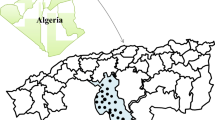Abstract
Fecal specimens were obtained from 3- to 8-month-old post-weaned dairy calves on farms in Vermont, New York, Pennsylvania, Maryland, Virginia, North Carolina, and Florida. After removal of fecal debris by sieving and density gradient centrifugation, 59 of 452 calves (13%) from 11 farms in six states were found positive for Enterocytozoon bieneusi by PCR and DNA sequence analysis. Based on gene sequence data this genotype of E. bieneusi found in post-weaned calves was 100% identical to that found in pre-weaned calves in North America and differed by only two positions in 1,069 base pairs from specimens analyzed from humans. However, compared with previous reports, the prevalence of E. bieneusi was significantly higher in post-weaned than in pre-weaned calves from many of the same farms.
Similar content being viewed by others
References
Breitenmoser AC, Mathis A, Bürgi E, Weber R, Desplazes P (1999) High prevalence of Enterocytozoon bieneusi in swine with four genotypes that differ from those identified in humans. Parasitology 118:447–453
Buckholt MA, Lee JH, Tzipori S (2002) Prevalence of Enterocytozoon bieneusi in swine: an 18-month survey at a slaughterhouse in Massachusetts. Appl Environ Microbiol 68:2595–2599
Cotte L, Rabodonirina M, Chapuis F, Bailly F, Bissuel F, Raynal C, Gelas P, Persat F, Piens M, Trepo C (1999) Waterborne outbreak of intestinal microsporidiosis in persons with and without immunodeficiency virus infection. J Infect Dis 180:2003–2008
David F, Schuitema AR, Sarfati C, Liguory O, Hartskeerl RA, Derouin F, Molina JM (1996) Detection and species identification of intestinal microsporidia by polymerase chain reaction in duodenal biopsies from human immunodeficiency virus-infected patients. J Infect Dis 174:874–877
Desplazes P, Mathis A, Müller C, Weber R (1996) Molecular epidemiology of Encephalitozoon cuniculi and first detection of Enterozytozoon bieneusi in faecal samples of pigs. J Eukaryot Microbiol 43:93S
Dengjel B, Zahler M, Hermanns W, Heinritzi K, Spillmann T, Thomschke A, Loscher T, Gothe R, Rinder H (2001) Zoonotic potential of Enterocytozoon bieneusi. J Clin Microbiol 39:4495–4499
Dowd SE, Gerba CP, Pepper IL (1998). Confirmation of the human-pathogenic microsporidia Enterocytozoon bieneusi, Encephalitozoon intestinalis, and Vitaforma corneae in water. Appl Environ Microbiol 64:3332–3335
Fayer R, Santín M, Trout JM (2003a) First detection of microsporidia in dairy calves in North America. Parasitol Res 90:383–386
Fayer R, Santín M, Palmer R (2003b) Comparison of microscopy and PCR for detection of three species of Encephalitozoon in feces. J Eukaryot Microbiol 50:572–573
Franzen C, Müller A (1999) Molecular techniques for detection, species differentiation and phylogenetic analysis of microsporidia. Clin Microbiol Rev 12:243–285
Gool T van, Luderhoff, E, Nathoo KJ, Kiire CF, Dankert J, Mason PR (1995) High prevalence of Enterocytozoon bieneusi infections among HIV-positive individuals with persistent diarrhoea in Harare, Zimbabwe. Tran R Soc Trop Med Hyg 89:478–480
Kotler DP, Orenstein JM (1998) Clinical syndromes associated with microsporidiosis. Adv Parasitol 40:332–351
Lores B, Aguila C del, Arias C (2002) Enterocytozoon bieneusi (Microsporidia) in faecal samples from domestic animals from Galicia, Spain. Mem Inst Oswaldo Cruz 97:941–945
Mansfield KG, Carville A, Shvetz D, MacKey J, Tzipori S, Lackner AA (1997) Identification of an Enterocytozoon bieneusi-like microsporidian parasite in simian immunodeficiency virus inoculated macaques with hepatobiliary disease. Am J Pathol 150:1395–1405
Mathis A, Breitenmoser AC, Desplazes P (1999) Detection of new Enterocytozoon genotypes in faecal samples of farm dogs and a cat. Parasite 6:189–193
Reetz J, Rinder H, Thomschke A, Manke H, Schwebs M, Bruderek A (2002) First detection of the microsporidium Enterocytozoon bieneusi in non-mammalian hosts (chickens). Int J Parasitol 32:785–787
Rinder H, Thomschke A, Dengjel B, Gothe R, Löscher T, Zahler M (2000) Close genotypic relationship between Enterocytozoon bieneusi from humans and pigs and first detection in cattle. J Parasitol 86:185–188
Sulaiman IM, Fayer R, Lal AA, Trout JM, Schaefer FW 3rd, Xiao L (2003) Molecular characterization of microsporidia indicates that wild mammals harbor host-adapted Enterocytozoon spp. as well as human-pathogenic Enterocytozoon bieneusi. Appl Environ Microbiol 69:4495–4501
Sulaiman IM, Fayer R, Yang C, Santín M, Matos O, Xiao L (2004) Molecular characterization of Enterocytozoon bieneusi in cattle indicates only some isolates have zoonotic potentials. Parasitol Res 92:328–334
Acknowledgements
The authors thank Robert Palmer, Kristie Ludwig, Courtney Anderson, and Kristin Cameron for technical services in support of this study.
Author information
Authors and Affiliations
Corresponding author
Rights and permissions
About this article
Cite this article
Santín, M., Trout, J.M. & Fayer, R. Prevalence of Enterocytozoon bieneusi in post-weaned dairy calves in the eastern United States. Parasitol Res 93, 287–289 (2004). https://doi.org/10.1007/s00436-004-1132-6
Received:
Accepted:
Published:
Issue Date:
DOI: https://doi.org/10.1007/s00436-004-1132-6




